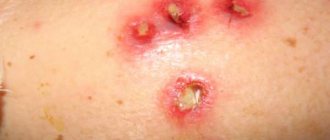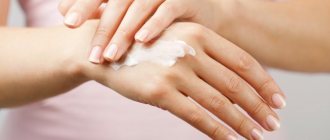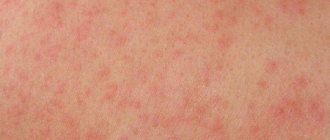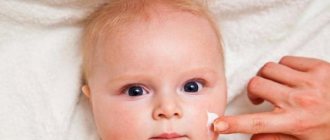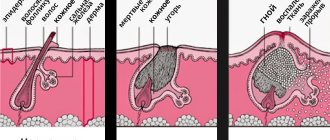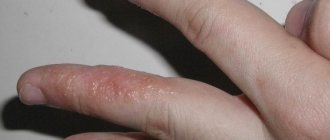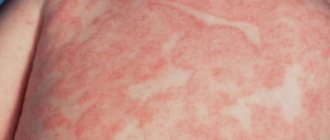Home › Child under one year old › Diseases
Author of the article
Ekaterina Rakitina Doctor Dietrich Bonhoeffer Klinikum, Germany
Reading time: 4 minutes
AA
Article last updated: 02/13/2019
Hands are the most “favorite” place for various rashes. A rash on a child’s hands is most often a manifestation of an allergic reaction. The Internet is replete with various photos on this topic, so it’s not so difficult to guess what type of rash covers your baby’s hands.
Treatment of allergies in children: types of disease
There are several types of allergies in children:
- Food . This type is the most common. Most often occurs in infants. Problematic foods include eggs, honey, milk, red fruits and berries. So first of all you need to exclude them from your diet.
- Dust . You need to understand that allergies do not manifest themselves to the dust itself, but to the mites living in it. They are not visible to the eye, so it is impossible to see them. Despite their microscopic size, they cause enormous harm to human health.
- Respiratory . This type appears often. The reason for this is animal fur, plant pollen, dust and much more circulating in the air. All this reduces the immune system, which begins to react incorrectly to irritants. Symptoms of such an allergy are unpleasant sensations in the nasopharynx, which can lead to suffocation.
- Skin . How does it manifest itself? A rash and red spots appear on the skin. That is, eczema, urticaria or dermatitis appears.
- Hay fever . The body's reaction to plant pollen.
- On animals, birds . It is important to understand that there is no allergy to the wool itself. The body reacts to skin scales, feces, urine, animal saliva, and bird feathers.
- On insects . Allergy to bites appears. It also often occurs when inhaling insect waste products. Sometimes cockroaches cause bronchial asthma in children.
Based on the type of allergy the child has, the doctor prescribes treatment.
Manifestations and symptoms
If you notice signs of allergies in your baby’s hands, you should definitely show him to a specialist. Only a doctor can make a final diagnosis.
A reaction to household chemicals usually appears almost immediately after contact with the substance. This reaction is characterized by redness of the palms and severe itching. Very often this is accompanied by peeling and a burning sensation. If you do not eliminate contact with the allergen and do not treat the baby’s hands, cracks will form that spread to the subcutaneous fat layer. This situation may be complicated by the addition of pathological microflora and the development of a severe infectious process requiring hospitalization of the child.
The reaction to an insect bite is characterized by the appearance of separately located itchy spots. They rise above the surface of the skin, have the shape of a cone and increase when combed. The most common cause is the bites of mosquitoes, ants, bees and wasps, which do not go unnoticed. Therefore, in this case, the origin of the rash on the hands is not questioned.
Allergies in the hand area can also be a reaction to weather conditions. At low temperatures, the skin on the child’s unprotected palms begins to redden and itch. This is often accompanied by swelling of the fingers, which makes bending movements difficult. The skin on the hands becomes dry and vulnerable, sensitive to the slightest irritation. Of course, this causes discomfort and often frightens the baby. To prevent this situation, it is necessary to moisturize your hands with special creams before leaving the room and be sure to wear mittens. Unfortunately, we will have to give up playing in the snow and building snowmen.
Hand allergies occur as a reaction of the body to certain foods. This may be a low-quality product, as well as sweets with a high content of sugar, coffee or cocoa. If you notice redness or a small rash on your baby's palms, it may be time to take a closer look at what your baby eats.
Allergy medications
To relieve allergic symptoms and, therefore, alleviate the child’s condition, it is necessary to use antihistamines. Just keep in mind that no medicine can completely get rid of allergies. They only alleviate the condition and ensure the duration of remission - nothing more.
| Anti-allergy tablets for first generation children | Anti-allergy tablets for second generation children |
| Pipolfen | Ebastine |
| Diazolin | Zyrtec |
| Diphenhydramine | Cetirizine |
| Suprastin | Kestin |
| Fenkarol | Loratadine |
| Diprazine | Claritin |
| Clemastine | Terfen |
| Diphenhydramine | Terfenadine and others |
First generation tablets do not have a cumulative effect, so they are eliminated from the body a short time after taking them. Perhaps this is one of the main advantages. All these drugs do not have a very good effect on the nervous system. Because of them also:
- causes drowsiness;
- weakness appears;
- coordination is impaired.
That is why such tablets are given to children only when quick relief of allergic symptoms is required.
Separately, we note the drug Tavegil. It should not be given to newborn children. It has few side effects and long-lasting effects.
First generation tablets are quickly absorbed into the blood. Their duration of action is one day. They have the following advantages:
- do not cause drowsiness;
- there is the possibility of consumption at any time, regardless of when the meal was;
- safer than first generation drugs.
Main types of contact allergies
There are several types of contact allergies.
Allergic dermatitis - accompanied by severe redness, swelling and a rash in the form of blisters.
This disease has some distinctive features. Among them is a rash. It does not linger at the site where the allergen is introduced and spreads beyond it.
It is accompanied by weeping, a long course of the disease and a possible relapse. The child may be bothered by excessive sensitivity in the areas of the rash, burning and pain.
Toxic - allergic dermatitis - occurs as a result of drug allergies. Its symptoms are very similar to allergic dermatitis.
However, the duration of the course depends solely on the period of elimination of the allergen from the patient’s body.
Diaper dermatitis and prickly heat - develops due to exposure of the skin to the components that make up sweat, urine and feces.
Accompanied by redness and swelling. Infection with fungal or microbial flora is possible.
Eczema – there is itching, erythema, the appearance of blisters, scales and pustules. After opening, the bubbles may become covered with a green, gray-brown or yellow crust.
The disease mainly manifests itself in the cheeks, neck, chin or pubic area. Occurs at 3–4 months of a baby’s life.
May be hereditary or depend on constitutional predisposition. Eczema lasts from 1.5 to 2.5 years. After which it turns into another allergic disease.
Neurodermatitis - this disease is very similar to urticaria. It is characterized by a rash on all kinds of parts of the body. Finding an allergen for such a disease is extremely difficult.
Strophulus - most often the cause is a food allergen. Accompanied by nodular rashes in the arms, legs, buttocks.
What are the benefits of the tablets?
What advantages do the tablets have? First of all, it is worth highlighting their high efficiency - they act directly on the irritant (allergen). The tablets quickly dissolve in the stomach, after which they penetrate into:
- blood;
- skin epithelium;
- mucous membranes;
- lungs;
- bronchi.
In addition to tablets, there are drops, ointments and gels. But these are local remedies that help only when symptoms manifest themselves in the form of tearing, irritation in the nasopharynx, and skin rashes.
What is an allergy?
Allergies are commonly called various states of changes in the body's reactivity, an important expression of which is an increase in its sensitivity to various environmental influences.
Contact allergy is an inflammatory reaction of the skin that enters the body through the integument, conjunctiva or mucous membrane into a previously sensitized organism.
This delayed-type reaction develops over many hours and sometimes days, in the mechanism of which the leading role is played by the processes of irritation of the skin by allergens, as a result of which various types of inflammation are formed.
Allergy ointments
Allergy ointments for children not only help eliminate the symptoms of the disease, but also protect the skin from infections. Such funds have their own characteristics. So, ointments are almost instantly absorbed into the skin, so they help quickly.
Like pills, these medications should also be selected by a doctor. The fact is that children's skin is very sensitive. This means that an incorrectly selected ointment will aggravate the situation: the allergy will take an even more severe form and will not respond to treatment.
Ointments for allergies in children are hormonal, non-hormonal and combined. The latter can have an antifungal effect, contain an antibiotic, have a moisturizing effect, nourish the skin and regenerate it.
| Hormonal | Non-hormonal | Combined |
| Epidel Can be taken from three months | Afloderm Indicated from six months | Pantoderm |
| Skin cap Can be used by children from one year old | Belogent For children from one year old | Radevit |
| Fenistil From the first days | Flucinar Prescribed to children from 2 years of age | Aven Trikzera |
| Dimetinden From birth | Bepanten | |
| Desitin Use for children who are 1 month old | Dexpanthenol | |
| Gistan Used from the age of 1 month | D-panthenol | |
| We see | ||
| Bepanten plus |
Don't be afraid of hormonal ointments. In modern products, hormones are contained in very small quantities, but, however, they can still lead to serious consequences. That is why they must be used very carefully. For the first time, you should apply just a little ointment to the skin.
Manifestations
Clinical manifestations are characterized by a variety of rashes, which depend on the degree of sensitization of the body. First, a mild erythema , on which papules, vesicles and blisters are located. These skin elements are located asymmetrically, without clear boundaries, and most often extend to areas adjacent to the contact zone. Small bubbles open, which leads to the formation of small erosions, on which weeping appears in the form of small droplets with further drying of the serous exudate and the appearance of crusts and peeling.
After the cessation of contact between the skin and the allergen, clinical manifestations begin to regress (within 2-4 weeks).
If you pay attention to the localization of the pathological focus, you can provide diagnostic information about the cause of contact allergies. If the rash is on both earlobes, the allergy is most likely caused by jewelry, which most often contains nickel. When the source of inflammation is located near the navel, this may be the result of exposure to a metal fastener or belt buckle. Linear redness and blisters usually represent a plant allergy (poison ivy, oak, or sumac).
Allergy drops for children
Children's bodies show a sensitive reaction to any medications. That is why all remedies have many contraindications (at least most of them). To minimize side effects, antihistamines are used, including nasal drops for allergies in children.
| Drops for newborns (nose and eyes) | Nasal drops for allergies for children over one year old | Allergy eye drops |
| Prevalin | Vibrocil | Kromosol |
| Zodak | Prevalin | Cromoghlin |
| Fenistil | Nasonex | Lecrolin |
| Zyrtec | Avamis | High-chrome |
| Vibrocil | Cromohexal | |
| Flixonase |
Causes
Allergies are caused by:
- Metals such as nickel, chromium, cobalt, gold, silver, etc., which are found on clothing and jewelry.
- Chemicals: powders, perfumes, creams, shampoos and others.
- medications: antibiotics, anesthetics, glucocorticoids and other drugs that are used locally.
- Products containing latex (swimwear, workout clothes);
- Plants such as primrose, ivy, chrysanthemum, hogweed, etc.
atopic dermatitis deserve special attention . Studies have noted that this group of patients has a minimal risk of contracting a similar disease through contact dermatitis. Although there are official refutations of this statement from several patients.
77 percent of sensitized patients in one large study were atopic, indicating that atopic dermatitis is a predisposing factor for contact hypersensitivity. Children with atopic dermatitis are often exposed to many of the preservatives and fragrances in creams used for treatment, increasing the likelihood of a reaction to these agents.
Treatment of drug allergies
Even if a drug allergy is suspected, all prescribed medications should be discontinued;
Treatment depends on the type of allergic reaction and its severity.
In case of acute reactions, the following are indicated: gastric lavage, saline laxatives, administration of enterosorbents (Smecta, Enterosgel, Polyphepan), and antihistamines.
For severe skin lesions, bed rest and drinking plenty of fluids are indicated; in severe cases, hospitalization is required. The above treatment is also carried out. When a bacterial infection occurs, antibacterial drugs are prescribed.
Treatment for drug allergies is largely symptomatic. If the mucous membranes of the oral cavity are affected, warm rinses with a 10% soda solution and local anesthetics; in case of eye damage, apply hydrocortisone ophthalmic ointment.
In severe cases, drug allergies may require infusion therapy, hormones, parenteral nutrition, and other intensive care methods.
When carrying out treatment, it is necessary to be especially careful in choosing certain drugs so as not to provoke a new reaction.
Prevention
- Primary prevention of drug allergies - doctors and parents should be extremely vigilant when choosing indications for prescribing medications, especially in children with atopic dermatitis, in newborns and children in the first year of life.
- Secondary prevention - avoiding the administration of a medication that has already caused an allergic reaction in the child;
- Mandatory recording of information about the first allergic reaction on the front side of the outpatient history of the child’s development and on the medical history in the hospital.
